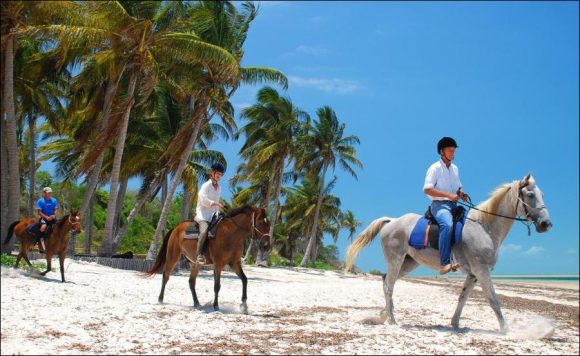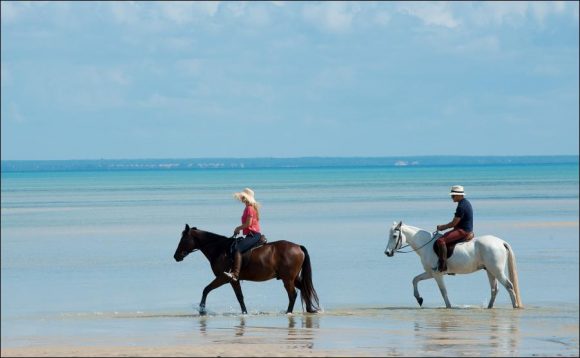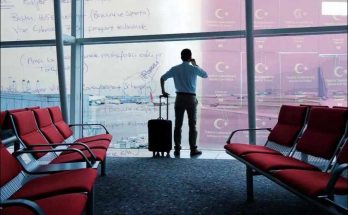The engine groans. Water sputters. The boat leans, and a fellow passenger’s pink, whipped cream-topped birthday cake threatens to slip from her lap to the ground. “If you’re scared we can take the bigger ferry,” my guide Januario tells me.
No need. I emerge safely on the other side of Maputo Bay, Mozambique. Battered fishing boats rock on the water, stalls of tiny fish bake in the sun and locals are gathering for their 8am shandy. I clamber into a minibus and watch the driver’s orange rosary beads sway to Rihanna’s hits, which blare through tinny speakers to the homes that dot the road.
The road: everyone’s favourite topic. Although my journey may sound chaotic, all that’s all about to change. I’m on my way from Maputo, Mozambique’s capital, to explore the pristine beaches of the country’s south. A year ago this journey could take up to eight hours, the route only accessible to fearless 4×4 drivers who weren’t afraid to push their jeeps out of muddy ditches.
But in a few months, thanks to a new bridge (cutting out long car ferry crossings) and new tarmac road (its last lines of paint are being completed as I type) the journey will be condensed into a cushy 90-minute drive. It’ll fast-track travellers to Ponto do Ouro, a beach town in the south, while easing access to a smattering of hotels that line the undiscovered coastline.
I’m starting a little further north at Anvil Bay, a luxury eco camp that’s set deep in Maputo Special Reserve. Entirely new on the British tourist’s radar, the thrillingly remote beach lodge has been a decade in the making, its existence the combined efforts of several charitable foundations and a community association representing the local villages who’ll benefit from the lodge’s earnings.
Just getting there makes me smile. At the Jurassic Park-style gates of the reserve I swap from the minibus to take on the web of sandy tracks and savannahs by 4×4. The space was earmarked in 1932 to safeguard the country’s coastal elephants – nowadays, thanks to a game restocking programme, it has blossomed into a vast protected playground for wildebeest, hippos and some of the most spectacular bird populations in the country, including polka dotted crested guinea fowl.
It’s not unusual to see elephants on the drive – close to 500 live here – but the herds are strolling further south today. Instead I spot hippos rolling in water, inquisitive zebras and a spindly-legged saddle-billed stork, which struts the side of a lake like it’s a catwalk.
I hope they’re happy to share, because we’re virtually roommates. Anvil Bay creeps up on me, its footprint so small, its nine casinhas, or rooms, barely visible in the coastal forest. Mine sits buried in branches on the beach dunes, its stilted, majega thatch and canvas design allowing a cooling ocean breeze to flow through the refreshingly simple suite, with soft linens, a huge bed made with local wood and jugs of reverse osmosis water. It’s the only luxury outpost in the reserve, though a budget campsite lies some distance north. Apart from that? Nothing.
I’d happily spend all day in the envigorating outdoor shower, but sunshine beckons. I follow the path from my room and emerge onto squeaky Tic Tac-white sand which gazes out over turquoise waves tumbling 30 meters on. It stretches north and south as far as I can see, the sand barely trodden, aside from the tell tale tracks of a turtle that ambled onto the beach to lay her eggs last night. I stroll two miles south, then back north, and throw myself in in the whitewater and jump waves. I don’t see another soul.
For three days I manage to do that rare thing: relax. Anvil Bay’s charm lies in switching off (there’s no Wi-Fi unless you go to the ‘restaurant’ tent) and embracing the beach’s isolated serenity. The most strenuous sight of my stay is watching another guest – a former head honcho of the World Bank who’s celebrating his 50th wedding anniversary – unbuckle his sandals to snooze on a lounger.
I’m a smidge more active. I try fishing off the beach, casting my line into ocean so green you’d swear it’d been tampered with. I wade a fat bike through the sand to reach the northernmost point I can see, and binge on more romance fiction than I should probably admit to. Come sunset I guzzle chilled local beers under a dusty pink sky, which transforms into a vast inky blanket pricked by stars. When everyone goes to bed I sit around the campfire and revel in the silence. It’s utterly intoxicating.
Yet Mozambique’s charm doesn’t rely on a luxe price tag. Inspired to see more, I head south to Ponto do Ouro, a ramshackle surf town that nudges the border of South Africa. My base is Gala Gala Eco Resort, a colourful, hugely loved guesthouse that reminds me of the glory days of backpacking. I set out to explore, taking a path down to the ocean and emerging onto one of the most thrilling stretches of sand I’ve seen.
Empty. I kick off my flip flops and wander along the beach with an entourage of several hundred dolphins. They dip in and out of the waves barely 10 metres from my feet, and stay with me until I climb around the headland of Ponto do Ouro, meaning ‘tip of gold’ – a nod to the bay’s southern cape.
Picnicking families are spread out on the butter-coloured sand, their smokey barbecues mingling with the salty air of the surf-pounded beach. Behind them, sandy lanes of paint-doused stalls sit next to crumbling baroque villas adorned with pretty, moss-strewn Portuguese tiles – a reminder of Mozambique’s colonial past.
A walk through town soon reveals that Ponto do Ouro serves up its own heavenly version of rest and relaxation. R&R – a half rum, half raspberry pop flouro-pink cocktail that’s fondly downed by locals and visitors – comes with a wink and warning. “One is good, two is great. No more than three,” the bar’s owner tells me. I’ve never slept better.
The next day calls for something a little more sedentary. I drive 11 miles north to Ponta Mamoli and arrive at White Pearl, one of the few luxury resorts on this southern coast. The clue’s in the name: the all-white interiors and ludicrously squidgy sun loungers-with-views are the sublime antithesis to Ponto’s bustle.
It’s here I explore another seemingly never-ending stretch of wave-lashed sand. I saunter along the coast on a ginger-tinged horse called Blazy (“because she’s a little lazy,” Lorenzo, the hotel’s activities guru, tells me), squint through a telescope at the moon and devour traditional deep-fried Mozambican snacks. I could spend many hours bobbing about in the ocean, but the new road has made it even easier to revisit the Maputo Special Reserve, rolling a bush and beach break into one afternoon.
Please, let me see elephants this time. I’m in the right hands. Domingos, my guide and a former reserve warden, is an expert in predicting football scores – and the animals’ whereabouts. We turn off the tarmac and take a ‘hippo highway’, so called because the animal’s dung lies fresh in the sand. We stop to pick black monkey oranges, a slippery stoned fruit that tastes like custard.
We watch monkeys launch themselves from the low, wide branches of waterberry trees, see 12 giraffes striding regally alongside us and spy crocodiles snoozing in the late-afternoon sun. Finally, in the distance, we spot a herd of elephants. The jeep crawls closer and we watch them roam the grassy savannah until sunset.
Things move somewhat faster on my ocean safari. This southern stretch of coast is a hotbed for divers, and Lorenzo takes guests to the Pinnacles to see 12 species of (friendly) shark and Croc Creek (for crocodile fish).
All very good, but I have other things on my mind: dolphins. “Swimming with dolphins is a privilege, not a right,” Lorenzo tells me. “They can sense your mood, your anxieties, your stresses. They can tell you’re pregnant even before you do.” I’m nervous already.
The conditions are perfect: the sky a cloudless cornflower-blue, the wind low, the waves flat. We zip south along the coast, then follow it back north. Miles and miles of uninterrupted sand is backed by jungle forest, without a single eyesore in sight. Then we see them. A small pod of bottlenose dolphins starts wiggling around the front of our boat. “They are taking a nap,” Lorenzo says, “they close half their brain to swim and sleep at the same time.” Multitaskers, take note.
It would be rude to wake them. Instead we hurtle north, Lorenzo easing the throttle at a reef just off the beach. Mozambique’s tourism has previously suffered at the hands of political tension in the north, but here, 1,500 miles south, it’s a different story. “Investors want to build a port in this very spot,” Lorenzo says. “It would destroy the beach, the marine life and the peacefulness. We must all work to protect our coast.”
It’s hard to picture. Just metres away is another stretch of empty, dazzling white sand leading into lively jade-coloured ocean. I promise to play my part, pull on my snorkel and fins, and jump straight in.
Visits: 75





